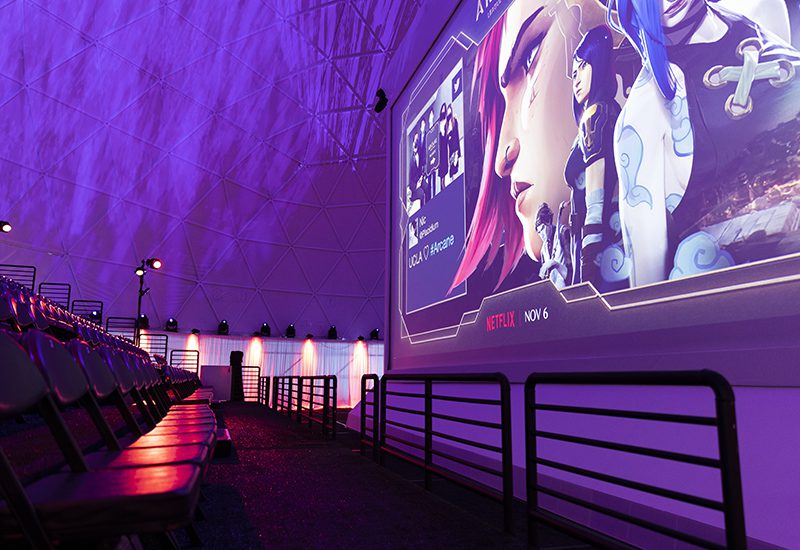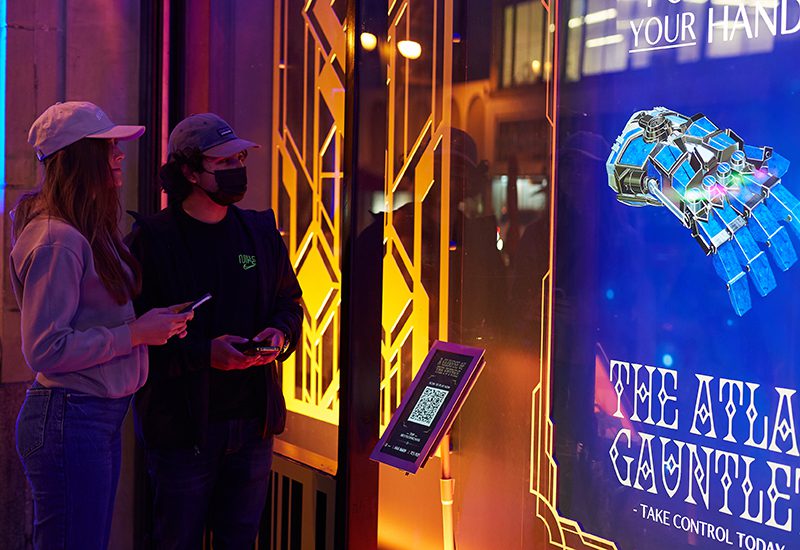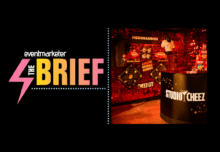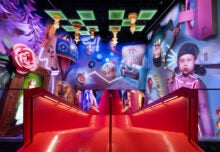Riot Games’ foray into entertainment experiences helps the industry rethink the role of hybrid—while masterfully writing a new chapter for its legacy esports IP, League of Legends
Riot Games’ League of Legends is thought to be the world’s largest esports property with at least a dozen leagues that compete for a spot in the World Championship each year. Tournaments are livestreamed on platforms like Twitch and YouTube, and have even been picked up by ESPN, attracting tens of millions of unique viewers who tune in to watch expert gameplay as a variety of “champion” characters level-up and protect or take over the map.
But, there’s always room for growth—and the next generation. And with the 10th anniversary of League of Legends in 2019, Riot Games announced it would expand the IP into a new market—entertainment—by working with Fortiche Production to combine the rich lore of League with a new animated Netflix series, “Arcane.” The goal: Target the casual viewer and earn the attention of skeptics, while deepening relationships with loyal fans by giving them yet another outlet in which to engage in League.
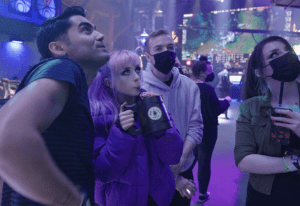
With the help of actors from Secret Cinema, Riot Games surprised unsuspecting influencers and players with an IRL version of the fictitious city of Zaun.
Amid the development of “Arcane,” the pandemic delivered an unexpected opportunity for this new venture with more consumers at home playing video games. It also meant that the formula to launch the series in November 2021 would need to stay true to pandemic-era consumption behaviors. Riot’s structure for the campaign was built around community-building, visibility and accessibility, and hybrid formatting played a key role in that quest.
With no formal experiential organization outside of its esports business to lean on, Riot, in a way, had the license to challenge all industry norms and write its own playbook from scratch. And so the RiotX Arcane campaign took shape.
“In the process of thinking through RiotX Arcane, we thought that the path to ‘Arcane’ for our current players was rooted in play. And that led us to some pretty in-depth discussions and decisions where we fundamentally questioned how we release TV shows,” says Brandon Miao, director-Cross Riot Product (XP) at Riot Games. “We wanted to build stop gaps into it, so that people could spend their in-between days during the week playing the game and feeling out more of the story from the hands-on perspective, before going back to the passive version of the story being told to them.”
 More Ex Awards Coverage:
More Ex Awards Coverage:
What might have been a one-off event for a series premiere in some previous life, instead was conceived as a storyline of touchpoints that kept unfolding over multiple weeks throughout the series’ run—all over the globe—with tune-in hype and social hype moments planned across digital broadcasts, gaming and immersive in-person events and activations. Indeed, this “global watch party” concept was inspired by gaming itself with the “interplay” of passive and active participation at the center.
The campaign involved a bounty of strategically timed events centered around the fact that the League of Legends World Tournament would kick off on Nov. 6—the same day the series premiered with the first three episodes made available as part of “Act 1.” And as the series progressed with the release of “Act 2” and “Act 3” over three weeks, the campaign unfolded in similar fashion.
Here’s how this “most player-focused company in the world” pulled it off.
“When you’re going to change the world, don’t ask permission.”
-Victor, “Arcane”
DESIGNING FOR TWO AUDIENCES
At a time when event marketers are struggling to define what hybrid means for their organizations, Riot Games summed it up neatly: Accessibility. RiotX Arcane was designed to “break down natural barriers to viewership and social engagement such as location, platform exclusivity, and cost through global, digitally integrated initiatives,” as the team described. It would begin with a premiere event, continue with activations around the globe, and conclude with a finale designed as a “love letter” to gamers.
Days before the premiere, Riot commissioned a bold projection takeover of the world’s tallest building, the Burj Khalifa in Dubai, featuring a three-minute teaser clip from the series. With the buzz-building underway, the brand planned an elaborate event at its headquarters in Los Angeles, transforming the brand’s campus into a livestreamed p.r. extravaganza complete with a red-carpet event ahead of the premiere viewing experience.
Under a seven-story-tall IMAX-inspired domed theater, those in attendance sat for a 360-degree “Arcane” viewing that featured an array of computer-controlled laser projections mapped on both the interior and exterior of the dome. With seating for more than 500 around the interior of the dome, a double-sided theater screen dubbed “the monolith” projected the screening while effects took place on the dome’s surface. At the same time, Riot co-streamed the premiere on Netflix and Twitch, where it made a new-era decision to enable influencers to share the stream freely with their communities around the world (VTProDesign, Los Angeles, handled the project mapping, video walls and interactive art walls at the premiere and finale events).
For those that couldn’t be on-site, hybrid elements included two-way interactions. On the red carpet, there were live two-way video interview booths occupied remotely by press or media outlets that acted as legitimate press stops for the talent and Riot leadership to drop into. Through the partnership with Twitch, two-way video-enabled robots allowed popular streamers from around the world to control them, roam the red carpet, and engage with attendees IRL.
Finally, building off of Twitch’s platform features, Riot worked directly with Twitch’s engineering and content teams to offer players digital drops for watching along with limited-time emotes and in-game content that could be used across their ecosystem for the duration of the show’s run. It all mapped back to that “in-between time” Riot wanted to capture when fans were not watching the show.
“Riot didn’t treat any of the digital components as an afterthought. Those were legitimate stops on the carpet and it was just as important for talent or Riot leadership to stop in and talk with those streamers and press outlets digitally,” says Heather Rasmussen, director-creative strategy at L.A.-based Redrock Entertainment, lead agency on the in-person experiences. “It redefined the role of passive engagement as, ‘What if it was actually cool to be at home?’ The digital production value and the design by the broadcast team was just as important as it was for the programming for the people on-site.”
“We spent a lot of time and energy making sure that new audiences saw a community in action first, and getting fans’ feelings on camera before pointing them to the show.”
—Brandon Miao, Director of Cross Riot Product (XP), Riot Games
WORLDWIDE POP-UP EXPERIENCES
In time for the series’ “Act Two” release of three more episodes was the campaign’s “Act Two” designed to follow the natural arc of storytelling with a dramatic turn of events.
Seeking global reach, Riot Games took over storefronts in six cities (Paris, London, Madrid, Istanbul, Singapore and Los Angeles) teasing the fictitious grand opening of flagship stores for “Hex Expos”—Hex being a “crystal technology” featured in the “Arcane” storyline. Over three days, passersby were prompted to use their devices to experience an augmented reality layer triggered by the storefront and that allowed them to “control the crystal” (We Are Collider, London, handled the pop-up expos and other OOH extensions globally).
In a plot twist, right before the fake stores were set to open, they were vandalized and the Hextech “stolen.” The destruction eventually impacted each city’s location with different types of damage or props applied as Easter eggs—hints to what was coming next in the series. The final store, in Los Angeles, fell and the culprit was revealed in time for the series’ finale.
View this post on Instagram
From the influencer access to the worldwide touchpoints, Riot was steadily building a case for tune-in and, perhaps, a case to get to know League a little better.
“We also looked at audiences who were familiar with League of Legends as a game, which is so globally well-known, and if you know it and don’t play it, or rejected it for any reason, we thought: You have to be a skeptic for some reason, and we’re not going to show you more League of Legends to make you want to watch League of Legends,” Miao says. “We decided to use all of our partner channels, all the groups that had the ability to speak to that group of skeptics, and point them toward our community.”
A ‘PLAYER-FOCUSED’ FINALE MOMENT
Unlike the typical formula in entertainment, Riot Games ended the series with an even bigger celebratory moment than the kickoff. Timed with the release of Act 3 of “Arcane” on Nov. 20, Riot Games created Undercity Nights, a weekend of gaming competition, thematic food and a shared watch experience in Pasadena, CA, for fans, players and global content creators.
“In entertainment, you don’t often see many finale events. You typically have a premiere and maybe some watch parties. But for us, this finale event really felt ‘Riot-ous.’ And by that, I mean we were connecting with our players and the global community doing all the things we all love to do every day,” says Megan Pulver, executive producer-Cross Riot Product (XP) at Riot Games. “If the premiere was this big, celebratory moment—an elevated experience of a lifetime for those who have wanted something like this for years—the finale was us at our most authentic, everyday selves. Much of that was bringing things our players are passionate about together in one moment where you’re seeing the games and IP you’ve poured so much of your time into, literally come to life in a lot of ways. Our players have a lot of interests outside of gaming like food, music, entertainment, and play, so bringing those elements together in the world of ‘Arcane,’ felt like a really cool way to express our version of a ‘player-focused’ moment.”
In a studio venue, the teams built a replica of the undercity of Zaun from “Arcane,” including the bar named The Last Drop. Attendees were given few details about what was to unfold at the RiotX Arcane event and once on-site they were ushered around by characters that put them in the shoes of “Arcane’s” formidable crime lords in a Secret Cinema experience (a theatrical company specializing in immersive film and entertainment). Suddenly, the doors opened and attendees realized they were walking into the underworld of Zaun, with their reactions all captured for content by Riot.
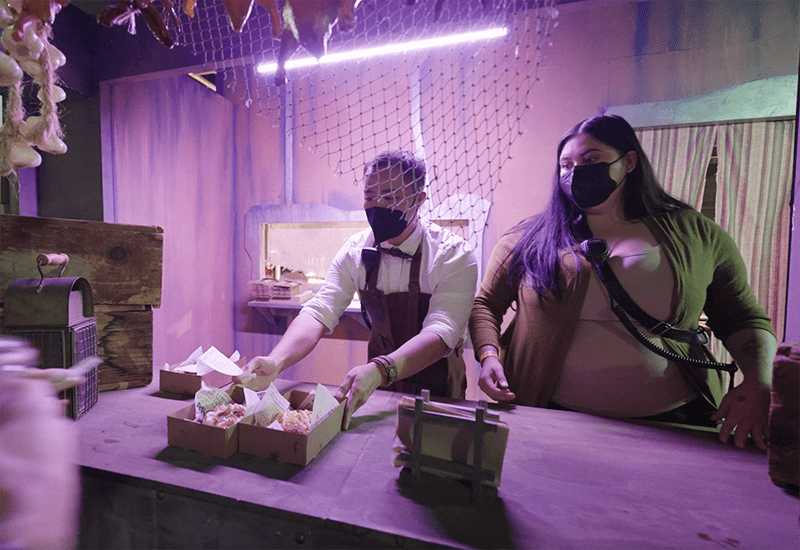
Riot Games recreated “The Last Drop” watering hole featured in the series for the finale event, right down to the menu.
They enjoyed thematic food (like the Shimmer drink from the series brought to life) and interacted with the actors in full character armed with scripts to gain clues to access secret rooms that were also replicas from the series—scenes that all mapped back to the storyline and series finale. Oh, and it was all livestreamed for audiences around the world, of course.
Following the RiotX Arcane Secret Cinema experience, The Riot Gauntlet took place each day, which was a charity tournament with a $100,000 prize pool to be donated to the winner’s charity of choice. Day two also featured Arcane Finale Conversation, a live-streamed panel with the cast and creators, musical performances by Bones UK, Pusha T, Mako, Miyavi and PVRIS—who are all featured in the “Arcane” soundtrack—as well as The Riot Gauntlet Finals, and series’ finale celebration.
For Riot Games, “Arcane” and the RiotX Arcane campaign was designed to build affinity for its gaming products by capitalizing on the lore of League of Legends. But it was also about making room for future fans to find a new community. As Miao put it: “We spent a lot of time and energy making sure that new audiences saw a community in action first, and getting fans’ feelings on camera before pointing them to the show.”
Riot Games worked with approximately 40 global partners, and the RiotX Arcane campaign involved all offices—some 3,500 employees worldwide, with multiple spinoff marketing campaigns. The team navigated evolving Covid-19 guidelines by region and market, and relied heavily on health and safety checks and balances, including robust testing requirements, as well as their multi-layered contingency plans.
“We were dealing with a lot of unknowns and an ambitious project with a high bar, but from the get-go we knew we wanted to bring this to more players around the world digitally, who couldn’t come to our IRL experiences and be with us in the intended way,” Pulver says. “But also, part of our best practices is we had contingencies for contingencies and they weren’t an afterthought, they were legitimately planned out with time and resources dedicated to them. And digital played a role in that.”
The work paid off. “Arcane” hit the No. 1 spot on Netflix’s Top 10 charts in more than 50 countries. A clear win. But there’s more. As a result of the holistic campaign, Riot recorded more than three billion hours of Riot Games played in November 2021—more than three times the average hours played by an American gamer, and the equivalent to the entire global population playing a Riot game for 22.7 minutes.
Not only did the campaign give a boost to the series, but the series gave the overall business a boost, too. And in a tepid year like 2021 was for experiential marketers, Riot’s perseverance and willingness to embrace the possibilities of hybrid to deliver access and build community is a story worthy of the Grand Ex.
This story appeared in the Summer 2022 issue

